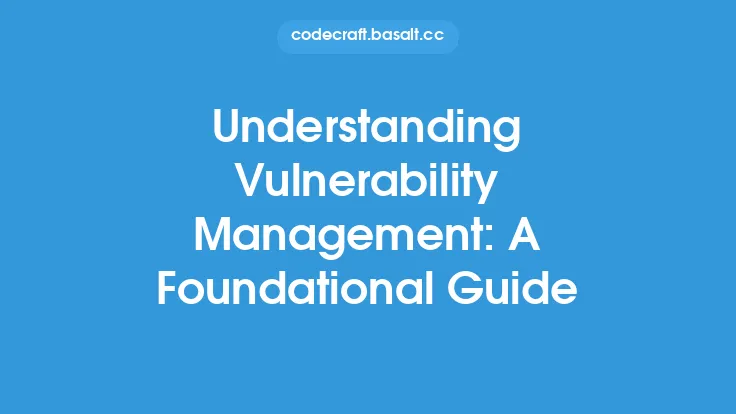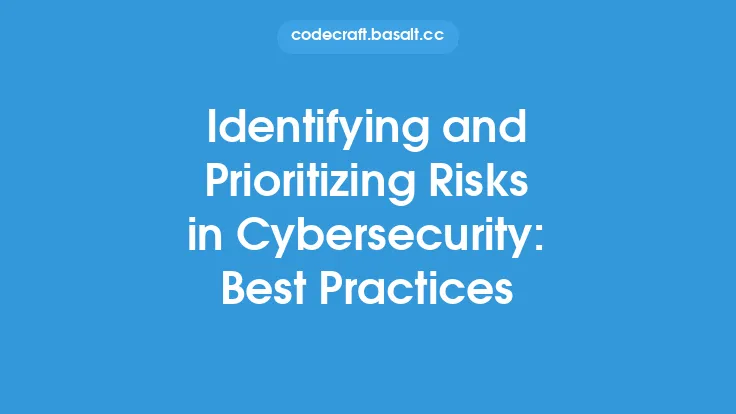Implementing a vulnerability management program is a critical component of any organization's cybersecurity strategy. Vulnerabilities in software, hardware, and configurations can be exploited by attackers to gain unauthorized access, disrupt operations, or steal sensitive data. A well-designed vulnerability management program helps identify, prioritize, and remediate vulnerabilities, reducing the risk of a security breach. In this article, we will discuss the best practices and considerations for implementing a vulnerability management program.
Introduction to Vulnerability Management Programs
A vulnerability management program is a systematic approach to identifying, assessing, and mitigating vulnerabilities in an organization's systems, networks, and applications. The program should be designed to ensure that vulnerabilities are identified and remediated before they can be exploited by attackers. A vulnerability management program typically includes several key components, such as vulnerability scanning, risk assessment, prioritization, remediation, and verification. The program should be integrated into the organization's overall cybersecurity strategy and should be aligned with industry best practices and regulatory requirements.
Key Components of a Vulnerability Management Program
A vulnerability management program should include several key components, including:
- Vulnerability scanning: This involves using automated tools to identify potential vulnerabilities in systems, networks, and applications.
- Risk assessment: This involves evaluating the potential impact of identified vulnerabilities and prioritizing them based on their risk level.
- Prioritization: This involves prioritizing vulnerabilities based on their risk level and the potential impact of a security breach.
- Remediation: This involves taking steps to mitigate or remediate identified vulnerabilities, such as applying patches or implementing workarounds.
- Verification: This involves verifying that remediation efforts have been successful and that vulnerabilities have been mitigated.
Best Practices for Implementing a Vulnerability Management Program
Several best practices should be followed when implementing a vulnerability management program, including:
- Conducting regular vulnerability scans to identify potential vulnerabilities.
- Using a risk-based approach to prioritize vulnerabilities and focus on the most critical ones first.
- Implementing a remediation plan that includes applying patches, implementing workarounds, and taking other steps to mitigate vulnerabilities.
- Verifying that remediation efforts have been successful and that vulnerabilities have been mitigated.
- Continuously monitoring systems, networks, and applications for new vulnerabilities and taking steps to mitigate them.
- Integrating the vulnerability management program with other cybersecurity initiatives, such as incident response and security awareness training.
Considerations for Implementing a Vulnerability Management Program
Several considerations should be taken into account when implementing a vulnerability management program, including:
- The organization's overall cybersecurity strategy and goals.
- Industry best practices and regulatory requirements.
- The organization's risk tolerance and appetite.
- The potential impact of a security breach on the organization's operations and reputation.
- The resources and budget available to support the vulnerability management program.
- The need to integrate the vulnerability management program with other cybersecurity initiatives and business operations.
Technical Considerations for Vulnerability Management
Several technical considerations should be taken into account when implementing a vulnerability management program, including:
- The use of automated vulnerability scanning tools to identify potential vulnerabilities.
- The implementation of a vulnerability management platform to track and manage vulnerabilities.
- The use of patch management tools to apply patches and updates to systems and applications.
- The implementation of configuration management tools to track and manage system and application configurations.
- The use of encryption and other security controls to protect sensitive data and systems.
- The implementation of network segmentation and isolation to limit the spread of malware and unauthorized access.
Common Challenges in Implementing a Vulnerability Management Program
Several common challenges may be encountered when implementing a vulnerability management program, including:
- Limited resources and budget to support the program.
- Lack of visibility into systems, networks, and applications.
- Inadequate risk assessment and prioritization.
- Ineffective remediation efforts.
- Limited integration with other cybersecurity initiatives and business operations.
- Difficulty in measuring the effectiveness of the program.
Overcoming Challenges in Implementing a Vulnerability Management Program
Several strategies can be used to overcome common challenges in implementing a vulnerability management program, including:
- Developing a comprehensive vulnerability management strategy that aligns with the organization's overall cybersecurity goals.
- Implementing automated vulnerability scanning and management tools to improve visibility and efficiency.
- Using a risk-based approach to prioritize vulnerabilities and focus on the most critical ones first.
- Providing training and awareness programs to educate employees on the importance of vulnerability management and their role in the program.
- Continuously monitoring and evaluating the effectiveness of the program and making adjustments as needed.
- Integrating the vulnerability management program with other cybersecurity initiatives and business operations to improve overall cybersecurity posture.
Conclusion
Implementing a vulnerability management program is a critical component of any organization's cybersecurity strategy. By following best practices and considering key components, technical considerations, and common challenges, organizations can develop a comprehensive vulnerability management program that helps identify, prioritize, and remediate vulnerabilities, reducing the risk of a security breach. Remember, a vulnerability management program is an ongoing process that requires continuous monitoring, evaluation, and improvement to ensure the organization's systems, networks, and applications remain secure and resilient.





